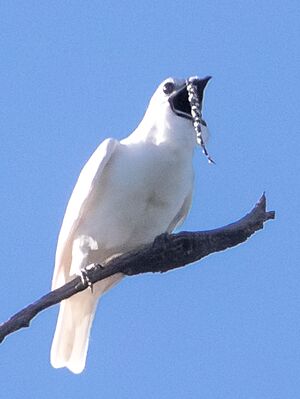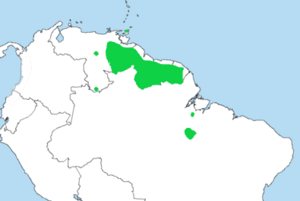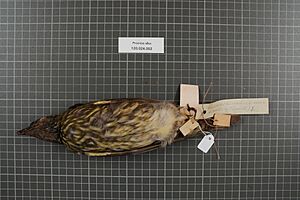White bellbird facts for kids
Quick facts for kids White bellbird |
|
|---|---|
 |
|
| Male at Carajás National Forest, State of Pará, Brazil. |
|
| Conservation status | |
| Scientific classification | |
| Genus: |
Procnias
|
| Species: |
albus
|
 |
|
| Range of P. albus | |
The white bellbird (Procnias albus) is a species of bird in the family Cotingidae. It is the world’s loudest bird, producing vocalizations of up to 125.4 decibels. The specific epithet is often spelled alba, but albus is correct due to the masculine gender of "Procnias". It is found in forests in the Guianas, with small numbers in Venezuela and the Brazilian state of Pará, as well as Trinidad and Tobago and Panama. As in two other members of Procnias, the males have wattles, fleshy structures akin to the red skin flap that hangs from the throat of roosters.
Description
The white bellbird grows to a length of about 28 cm (11 in). The male is pure white with a black bill that has a fleshy black wattle, sparsely feathered with white feathers, dangling from its top and hanging down the side, usually the right side; the female is an overall olive colour, with olive streaks on the yellowish underparts, and resembles other bellbirds. The male is unlikely to be mistaken for anything else, but the female resembles the bearded bellbird (Procnias averano); that bird has a dusky olive crown and black streaking on the throat.
According to a study published in 2019, the white bellbird produces the loudest call ever recorded in a bird, reaching 125 dB(A) (at equivalent 1m distance). The record was previously held by the screaming piha, which was recorded at 116 dB.
Distribution and habitat
The range of the white bellbird includes parts of Brazil, French Guiana, Guyana, Suriname, Trinidad and Tobago, and Venezuela. It occurs in moist tropical or subtropical forests.
Status
Although the white bellbird is an uncommon bird, its total population is estimated to be large. The population may be in slight decline because of deforestation, but not at a fast enough rate for it to be considered threatened, so the International Union for Conservation of Nature has rated its conservation status as being of "least concern".



